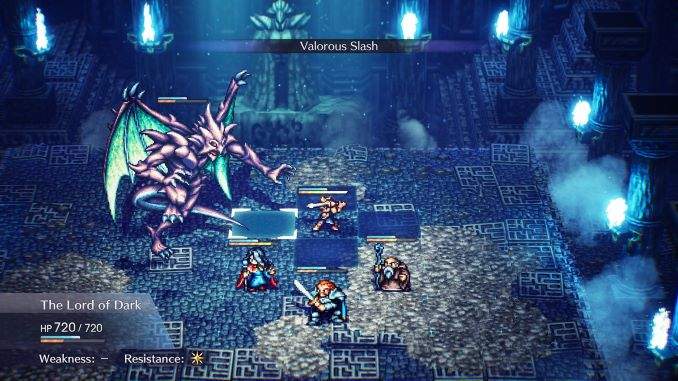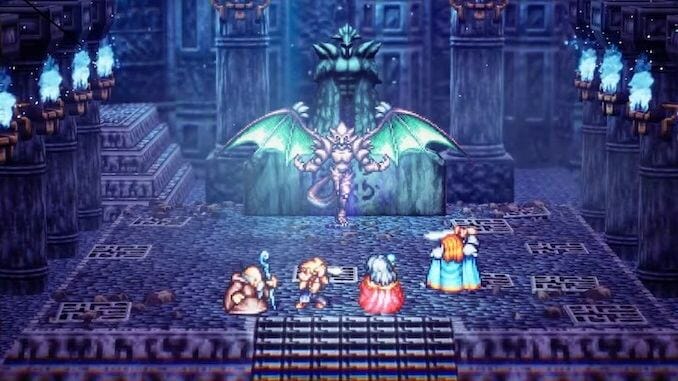The first RPG I ever played was an Android port of a Final Fantasy game I can’t remember the name of. I played it almost entirely on a road trip to Washington state when I was 13; when the trip was done, I never touched it again. It was difficult to move and attack correctly, the visuals had been redone in a 3D style that looked worse than whatever the original was, and maybe worst of all, the game’s relevance was lost on me—it floated in my phone, historyless, just a series of battles that had released on some console at some point, and resurfaced for me to play and then immediately forget. On the opposite end is the last RPG I played, Final Fantasy VII Remake; it’s polished, easy to learn, and with a deep sense of its own history and importance.
I mention all of this to say that most of my engagement with RPGs released pre-2012 has been through remakes, remasters, and ports, material repackaged to appear more approachable to people like me, who are used to mini-maps that rival Google Maps for effectiveness, quest logs that update every few minutes, battles that don’t (usually) take hours and umpteen tries to complete. In the best cases, I learn something about an era of games I was too young to experience the first time; in the worst, I work through a game that’s unapproachable either because of odd additions or lack of explanation of its original content. Usually it’s a mix of both; but occasionally, I come across a game that has many of the hallmarks of older RPGs that tend to grate at and frustrate me, but is so charming, is swinging for the fences so much of the time, that I can’t stay mad at it—at least not at first.
This is how I felt playing the demo version of Live a Live, a remake of a 1994 RPG developed by Takashi Tokita, the director of Chrono Trigger. It features seven chapters, each of which has a different central style of gameplay, a different story, and a different main character, and was designed by a different artist. While it was commercially unsuccessful at launch, it quickly became a cult favorite, and those who missed out on it in 1994 were reintroduced to the game when it launched on the Wii U virtual console in 2015, although only in Japan.
The remake is the game’s first ever release outside Japan and is also an HD-2D remake, a style made popular by 2018’s Octopath Traveler. The demo, which was released last week after Tuesday’s Nintendo Direct, contains the first part of three of the seven chapters, which can be played in any order and swapped between at any time.

As it has to deal with seven chapters that can be played in any order, the game has the challenge of introducing fundamentals like moving, fighting, and navigating multiple times without repeating itself. In the demo, at least, this issue is solved by making each of the three chapters center around a different way of engaging with the world. The Twilight of Edo Japan, for instance, teaches you how to fight organically as you infiltrate a castle, while the Distant Future is purely narrative and involves investigating strange happenings on a spaceship. The gameplay of each of the three chapters, as well as smaller details like the map style, feel distinct enough that the tutorials don’t overlap. The two fighting styles you’re introduced to are very different: one is based on environmental damage, while the other emphasizes status effects and closing distance.
Live a Live has a devotion to small details that comes across in its smaller moments as well. One very early example of this is when you’re playing as a robot named Cube in the Distant Future arc. Your creator teaches you how to make a coffee for him to drink. You can then, unprompted, deliver a coffee to each of your crewmates, with different responses from each of them. It’s a staggering amount of dialogue and variety, and given that each of the game’s seven chapters seems to be just as detailed, it’s even more impressive.
There are a number of other ways, however, that the game shows its age. Most of these are with quality of life issues that seem as though they could have been tweaked in this re-release. For example, one of the map screens shows objectives based on your current position, but not which floor they appear on; on maps with multiple floors, you’re often dependent on trial and error to figure out where to go. In combat, the range of your attacks’ effectiveness will display, but not descriptions of what their effect is, making early fights more confusing than they need to be.
Despite its initial detail, the action in each chapter can also feel a little shallow over time. I felt this especially during Edo Japan, which starts off strong by letting you sneak past guards or engage them in combat, and challenges you to remember a password that changes each time a bell rings. It’s a lot of information to keep track of, but once you have the hang of it, implementing it becomes a matter of choosing stealth or combat, executing on it, and then moving on to the next available point. This is satisfying, but even by the end of the demo I found myself losing interest.
Ultimately, I don’t know if I can see myself making it through the full version of Live a Live. Those with more tolerance for a slower pace, more backtracking, and fewer contemporary quality of life changes would probably have much more success with the game than I did. For those more interested in the story, the novelty of swapping between chapters, or even just Live a Live’s place in RPG history, the game’s charm is probably enough to keep them hooked. But for me, the unique seven-pronged story couldn’t quite make up for the fact that beyond their initial differences, the chapters often don’t have the same depth in their gameplay that the story and dialogue do. For this reason, I was left feeling that it couldn’t quite execute on its promise of wide variation and change; it does seven things well enough, rather than doing one or two exceptionally. It’s an interesting experiment with a rich history, but for now I’ve seen all the lives I need to see.
Emily Price is an intern at Paste and a columnist at Unwinnable Magazine. She is also a PhD Candidate in literature at the CUNY Graduate Center. She can be found on Twitter @the_emilyap.

